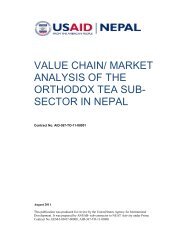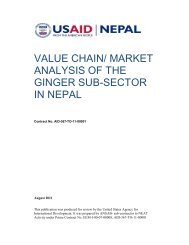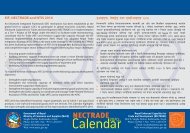value chain/ market analysis of the lentil sub-sector in ... - Nepal Trade
value chain/ market analysis of the lentil sub-sector in ... - Nepal Trade
value chain/ market analysis of the lentil sub-sector in ... - Nepal Trade
You also want an ePaper? Increase the reach of your titles
YUMPU automatically turns print PDFs into web optimized ePapers that Google loves.
2.2.3 Quality Standards<br />
<strong>Nepal</strong>ese exporters are not able to export large quantities <strong>of</strong> <strong>lentil</strong> to a number <strong>of</strong><br />
Organizations for Economic Cooperation and Development (OECD) countries such as <strong>the</strong><br />
USA, UK, Italy, Germany, Spa<strong>in</strong> and France due to restrictive sanitary and phyto-sanitary<br />
measures (SPS). In develop<strong>in</strong>g countries; India, South Asia Free <strong>Trade</strong> Agreement (SAFTA),<br />
Bay <strong>of</strong> Bengal Initiative for Multi-Sectoral Technical and Economic Cooperation<br />
(BIMSTEC) and South Asian Association for Regional Cooperation (SAARC) regions, <strong>the</strong><br />
SPS requirements are less str<strong>in</strong>gent and currently <strong>the</strong>re are no major obstacles for exports.<br />
However, <strong>Nepal</strong>ese exporters are likely to soon face requests from importers <strong>of</strong> <strong>the</strong> South<br />
Asian region for certification and compliance with SPS Codex Alimentarius standards.<br />
There is a need for <strong>Nepal</strong>ese <strong>lentil</strong> exporters to anticipate <strong>the</strong> South Asian <strong>market</strong>s str<strong>in</strong>gency<br />
on Codex Alimentarius standards, and design a short-term and long-term strategy to<br />
overcome regional SPS barriers for <strong>lentil</strong> exports. Until <strong>the</strong> <strong>Nepal</strong>ese <strong>in</strong>dependent<br />
certification is <strong>in</strong>ternationally recognized, exporters will have to contract services with Indian<br />
certification <strong>in</strong>stitutions or with bodies from <strong>the</strong> countries <strong>of</strong> dest<strong>in</strong>ation <strong>of</strong> <strong>the</strong>ir exports. If<br />
<strong>the</strong>y do not do so, <strong>the</strong>y will face obstacles: a) ei<strong>the</strong>r <strong>the</strong> rejection <strong>of</strong> <strong>the</strong>ir exports, or b)<br />
compla<strong>in</strong>ts from <strong>the</strong> clients <strong>in</strong> <strong>the</strong> import<strong>in</strong>g countries, based on <strong>in</strong>ternationally recognized<br />
laboratories tests, that could entail reduction <strong>in</strong> <strong>the</strong> prices paid or refusal <strong>of</strong> <strong>the</strong> consignment.<br />
The <strong>Nepal</strong> Bureau <strong>of</strong> Standard and Metrology has fixed <strong>the</strong> follow<strong>in</strong>g standards for split <strong>lentil</strong><br />
<strong>in</strong> <strong>Nepal</strong>. The Department <strong>of</strong> Food Technology and Quality Control (DFTQC) provides<br />
quality and/or grade certification to sample providers.<br />
Table 11: Lentil National Standards<br />
S N Quality Standard A Standard B<br />
1. Foreign materials not more than:<br />
1.a<br />
1.b<br />
1.c<br />
a) Inorganic (sand, soil, concrete)<br />
b) Organic (straw & materials)<br />
c) O<strong>the</strong>r foreign materials that can be eaten<br />
0.5%<br />
0.5%<br />
3%<br />
2 Damage by <strong>in</strong>sects 1% 2%<br />
3 Damage due to o<strong>the</strong>r causes 1% 2%<br />
4 Unbroken seed with seed coat 2% 3%<br />
5 Unripe and wr<strong>in</strong>kled seed 5% 8%<br />
6 Seed broken <strong>in</strong> small particles 2% 6%<br />
1%<br />
1%<br />
4%<br />
Value Cha<strong>in</strong>/ Market Analysis-Lentils 12






